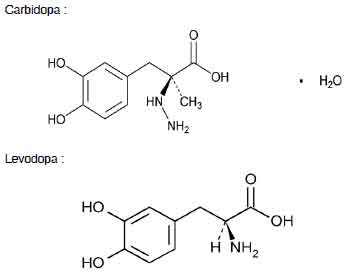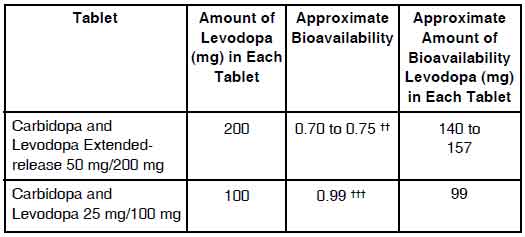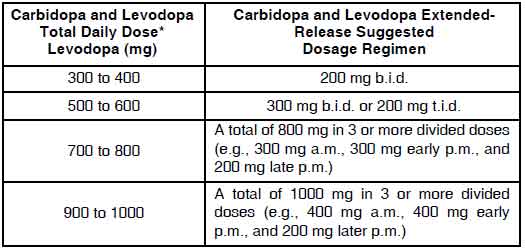
25 mg + 1000 mg
For the use of a Registered Medical Practitioner or a Hospital or a Institution only.
CARBIDOPA AND LEVODOPA EXTENDED-RELEASE TABLETS USP are a combination of carbidopa and levodopa for the treatment of parkinson’s disease and syndrome. Carbidopa is a peripheral dopa-decarboxylase inhibitor with little or no pharmacological activity when given alone in usual doses. Levodopa a naturally occurring amino acid, is the immediate precursor of the neurotransmitter dopamine. Chemically, Carbidopa is Benzenepropanoic acid, α-hydrazino-3,4-dihydroxy-α-methyl-, monohydrate, (s)-; (-)-L-α-Hydrazino-3,
4-dihydroxy-α-methylhydrocinnamic acid monohydrate. The molecular formula is C10H14N2O4 . H2O and the molecular weight is 244.24. Chemically, Levodopa is L-Tyrosine, 3-hydroxy-; (-)-3-(3,4-Dihydroxyphenyl)-L-alanine. The molecular formula is C9H11NO4 and molecular weight is 197.19.
STRUCTURAL FORMULA :
Its structural formula is :

CARBIDOPA AND LEVODOPA EXTENDED-RELEASE TABLETS USP are blue coloured, circular, biconvex tablet with breakline on one side and other side plain.
COMPOSITION :
Each extended-release uncoated tablet contains :
Carbidopa (anhydrous) USP 25 mg
Levodopa USP 100 mg
Excipients q.s.
Colour : Brilliant Blue FCF
ACTIONS :
Parkinson’s disease is a progressive, neurodegenerative disorder of the extrapyramidal nervous system affecting the mobility and control of the skeletal muscular system. Its characteristic features include resting tremor, rigidity, and bradykinetic movements. Symptomatic treatments, such as levodopa therapies, may permit the patient better mobility. Current evidence indicates that symptoms of parkinson’s disease are related to depletion of dopamine in the corpus striatum. Administration of dopamine is ineffective in the treatment of parkinson’s disease apparently because it does not cross the blood-brain barrier. However, levodopa, the metabolic precursor of dopamine, does cross the blood-brain barrier,and presumably is converted to dopamine in the brain. This is thought to be the mechanism whereby levodopa relieves symptoms of parkinson’s disease.
PHARMACODYNAMICS :
When levodopa is administered orally it is rapidly decarboxylated to dopamine in extracerebral tissues so that only a small portion of a given dose is transported unchanged to the central nervous system. For this reason, large doses of levodopa are required for adequate therapeutic effect, and these may often be accompanied by nausea and other adverse reactions, some of which are attributable to dopamine formed in extracerebral tissues. Since levodopa competes with certain amino acids for transport across the gut wall, the absorption of levodopa may be impaired in some patients on a high protein diet. Carbidopa inhibits decarboxylation of peripheral levodopa. It does not cross the blood-brain barrier and does not affect the metabolism of levodopa within the central nervous system. Since its decarboxylase inhibiting activity is limited to extracerebral tissues, administration of carbidopa with levodopa makes more levodopa available for transport to the brain.
Patients treated with levodopa therapy for parkinson’s disease may develop motor fluctuations characterized by end-of-dose failure, peak dose dyskinesia, and akinesia. The advanced form of motor fluctuations (‘on-off’ phenomenon) is characterized by unpredictable swings from mobility to immobility. Although the causes of the motor fluctuations are not completely understood, in some patients they may be attenuated by treatment regimens that produce steady plasma levels of levodopa. Each tablet contains either 50 mg of carbidopa and 200 mg of levodopa, or 25 mg of carbidopa and 100 mg of levodopa in a extended-release dosage form designed to release these ingredients over a 4 to 6 hour period. With carbidopa and levodopa extended-release there is less variation in plasma levodopa levels than with carbidopa and levodopa, the conventional formulation. However, carbidopa and levodopa extended-release is less systemically bioavailable than carbidopa and levodopa and may require increased daily doses to achieve the same level of symptomatic relief as provided by carbidopa and levodopa.
In clinical trials, patients with moderate to severe motor fluctuations who received carbidopa and levodopa extended-release did not experience quantitatively significant reductions in ‘off’ time when compared to carbidopa and levodopa. However, global ratings of improvement as assessed by both patient and physician were better during therapy with carbidopa and levodopa extended-release than with carbidopa and levodopa. In patients without motor fluctuations, carbidopa and levodopa extended-release, under controlled conditions, provided the same therapeutic benefit with less frequent dosing when compared to carbidopa and levodopa.
PHARMACOKINETICS :
Carbidopa reduces the amount of levodopa required to produce a given response by about 75 % and, when administered with levodopa, increases both plasma levels and the plasma half-life of levodopa, and decreases plasma and urinary dopamine and homovanillic acid. Elimination half-life of levodopa in the presence of carbidopa is about 1.5 hours. Following carbidopa and levodopa extended-release, the apparent half-life of levodopa may be prolonged because of continuous absorption. In healthy elderly subjects (56 to 67 years old) the mean time-to-peak concentration of levodopa after a single dose of 50 mg/200 mg carbidopa and levodopa extended-release was about 2 hours as compared to 0.5 hours after standard carbidopa and levodopa. The maximum concentration of levodopa after a single dose of carbidopa and levodopa extended-release was about 35 % of the standard carbidopa and levodopa (1151 vs. 3256 ng/ml). The extent of availability of levodopa from carbidopa and levodopa extended-release was about 70 to 75 % relative to intravenous levodopa or standard carbidopa and levodopa in the elderly. The absolute bioavailability of levodopa from carbidopa and levodopa extended-release (relative to I.V.) in young subjects was shown to be only about 44 %. The extent of availability and the peak concentrations of levodopa were comparable in the elderly after a single dose and at steady state after t.i.d. administration of 50 mg/200 mg carbidopa and levodopa extended-release. In elderly subjects, the average trough levels of levodopa at steady state after the
extended-release tablet were about 2 fold higher than after the standard carbidopa and levodopa (163 vs. 74 ng/ml).
In these studies, using similar total daily doses of levodopa, plasma levodopa concentrations with carbidopa and levodopa extended-release fluctuated in a narrower range than with carbidopa and levodopa. Because the bioavailability of levodopa from carbidopa and levodopa extended-release relative to carbidopa and levodopa is approximately 70 to 75 %, the daily dosage of levodopa necessary to produce a given clinical response with the extended-release formulation will usually be higher. The extent of availability and peak concentrations of levodopa after a single dose of 50 mg/200 mg carbidopa and levodopa extended-release increased by about 50 % and 25 %, respectively, when administered with food. At steady state, the bioavailability of carbidopa from carbidopa and levodopa tablet is approximately 99 % relative to the concomitant administration of carbidopa and levodopa. At steady state, carbidopa bioavailability from 50 mg/200 mg carbidopa and levodopa extended-release is approximately 58 % relative to that from carbidopa and levodopa.
Pyridoxine hydrochloride (Vitamin B6), in oral doses of 10 mg to 25 mg, may reverse the effects of levodopa by increasing the rate of aromatic amino acid decarboxylation. Carbidopa inhibits this action of pyridoxine.
INDICATIONS :
CARBIDOPA AND LEVODOPA EXTENDED-RELEASE TABLETS USP is indicated for the treatment of parkinson’s disease and syndrome. It is useful in relieving many of the symptoms of parkinsonism, particularly rigidity and bradykinesia. CARBIDOPA AND LEVODOPA EXTENDED-RELEASE TABLETS USP frequently helpful in the management of tremor, dysphagia, sialorrhoea, and postural instability associated with Parkinson’s disease and syndrome. When therapeutic response to levodopa alone is irregular, and signs and symptoms of parkinson’s disease are not evenly controlled throughout the day, substitution of CARBIDOPA AND LEVODOPA EXTENDED-RELEASE TABLETS USP usually is effective in reducing fluctuations in response. By reducing certain adverse reactions produced by levodopa alone, CARBIDOPA AND LEVODOPA EXTENDED-RELEASE TABLETS USP permits more patients to obtain adequate relief of the symptoms of parkinson’s disease. CARBIDOPA AND LEVODOPA EXTENDED-RELEASE TABLETS USP is also indicated for patients with parkinsonism who are taking vitamin preparations that contain pyridoxine hydrochloride (Vitamin B6).
Administration :
CARBIDOPA AND LEVODOPA EXTENDED-RELEASE TABLETS USP are for oral administration.
Dosage :
CARBIDOPA AND LEVODOPA EXTENDED-RELEASE TABLETS USP contain carbidopa and levodopa in a 1 : 4 ratio as either the 50 mg/200 mg tablet or the 25 mg/100 mg tablet. The daily dosage of carbidopa and levodopa extended-release must be determined by careful titration. Patients should be monitored closely during the dose adjustment period, particularly with regard to appearance or worsening of involuntary movements, dyskinesias or nausea. CARBIDOPA AND LEVODOPA EXTENDED-RELEASE TABLETS USP should not be chewed or crushed.
Initial Dosage :
Patients currently treated with conventional carbidopa-levodopa
preparations :
Studies show that peripheral dopa-decarboxylase is saturated by the bioavailable carbidopa at doses of 70 mg a day and greater. Because the bioavailabilities of carbidopa and levodopa in carbidopa and levodopa and carbidopa and levodopa extended-release are different, appropriate adjustments should be made, as shown in Table.
Table : Approximate Bioavailabilities at Steady State †

†† The extent of availability of levodopa from CARBIDOPA AND LEVODOPA EXTENDED-RELEASE TABLETS USP was about 70 - 75 % relative to intravenous levodopa or standard carbidopa and levodopa extended-release tablets in the elderly. ††† The extent of availability of levodopa from carbidopa and levodopa was 99 % relative to intravenous levodopa in the healthy elderly. Dosage with carbidopa and levodopa extended-release should be substituted at an amount that provides approximately 10 % more levodopa per day, although this may need to be increased to a dosage that provides up to 30 % more levodopa per day depending on clinical response. The interval between doses of carbidopa and levodopa extended-release should be 4 to 8 hours during the waking day. A guideline for initiation of carbidopa and levodopa extended-release is shown in below table.
Table : Guidelines for Initial Conversion from Carbidopa and Levodopa to Carbidopa and Levodopa Extended-Release

* For dosing ranges not shown in the table see DOSAGE AND ADMINISTRATION : Initial Dosage - Patients currently treated with conventional carbidopa-levodopa preparations. Patients currently treated with levodopa without a decarboxylase inhibitor :
Levodopa must be discontinued at least twelve hours before therapy with carbidopa and levodopa extended-release is started. Carbidopa and levodopa extended-release should be substituted at a dosage that will provide approximately 25 % of the previous levodopa dosage. In patients with mild to moderate disease, the initial dose is usually 1 tablet of 50 mg/200 mg CARBIDOPA AND LEVODOPA EXTENDED-RELEASE TABLETS USP b.i.d.
Patients not receiving levodopa :
In patients with mild to moderate disease, the initial recommended dose is 1 tablet of 50 mg/200 mg CARBIDOPA AND LEVODOPA EXTENDED-RELEASE TABLETS USP b.i.d. Initial dosage should not be given at intervals of less than 6 hours.
Titration with Carbidopa and Levodopa Extended-release :
Following initiation of therapy, doses and dosing intervals may be increased or decreased depending upon therapeutic response. Most patients have been adequately treated with doses of carbidopa and levodopa extended-release that provide 400 to 1600 mg of levodopa per day, administered as divided doses at intervals ranging from 4 to 8 hours during the waking day. Higher doses of carbidopa and levodopa extended-release (2400 mg or more of levodopa per day) and shorter intervals (less than 4 hours) have been used, but are not usually recommended. When doses of carbidopa and levodopa extended-release are given at intervals of less than 4 hours, and/or if the divided doses are not equal, it is recommended that the smaller doses be given at the end of the day. An interval of at least 3 days between dosage adjustments is recommended.
Maintenance :
Because parkinson’s disease is progressive, periodic clinical evaluations are recommended; adjustment of the dosage regimen of carbidopa and levodopa extended-release may be required.
Addition of Other Antiparkinson Medications :
Anticholinergic agents, dopamine agonists, and amantadine can be given with carbidopa and levodopa extended-release. Dosage adjustment of carbidopa and levodopa extended-release may be necessary when these agents are added. A dose of carbidopa and levodopa 25 mg/100 mg or 10 mg/100 mg (one half or a whole tablet) can be added to the dosage regimen of carbidopa and levodopa extended-release in selected patients with advanced disease who need additional immediate-release levodopa for a brief time during daytime hours.
Interruption of Therapy :
Sporadic cases of a symptom complex resembling Neuroleptic Malignant Syndrome (NMS) have been associated with dose reductions and withdrawal of carbidopa and levodopa or carbidopa and levodopa extended-release. Patients should be observed carefully if abrupt reduction or discontinuation of carbidopa and levodopa extended-release is required, especially if the patient is receiving neuroleptics. If general anaesthesia is required, carbidopa and levodopa extended-release may be continued as long as the patient is permitted to take oral medication. If therapy is interrupted temporarily, the patient should be observed for symptoms resembling NMS, and the usual dosage should be administered as soon as the patient is able to take oral medication.
CONTRAINDICATIONS :
Nonselective monoamine oxidase (MAO) inhibitors are contraindicated for use with CARBIDOPA AND LEVODOPA EXTENDED-RELEASE TABLETS USP. These inhibitors must be discontinued at least two weeks prior to initiating therapy with CARBIDOPA AND LEVODOPA EXTENDED-RELEASE TABLETS USP. CARBIDOPA AND LEVODOPA EXTENDEDRELEASE TABLETS USP may be administered concomitantly with the manufacturer’s recommended dose of an MAO inhibitor with selectivity for MAO type B (e.g. selegiline HCl). CARBIDOPA AND LEVODOPA EXTENDED-RELEASE TABLETS USP is contraindicated in patients with known hypersensitivity to any component of this medication, and in patients with narrow angle glaucoma. Since levodopa may activate a malignant melanoma,
CARBIDOPA AND LEVODOPA EXTENDED-RELEASE TABLETS USP should not be used in patients with suspicious undiagnosed skin lesions or a history of melanoma.
WARNINGS :
When this combination product is to be given to patients who are being treated with levodopa, levodopa must be discontinued at least twelve hours before therapy with this product is started. In order to reduce adverse reactions, it is necessary to individualize therapy.
The addition of carbidopa with levodopa in the form of the combination product reduces the peripheral effects (nausea, vomiting) due to decarboxylation of levodopa ; however, carbidopa does not decrease the adverse reactions due to the central effects of levodopa. Because carbidopa permits more levodopa to reach the brain and more dopamine to be formed, certain adverse CNS effects, e.g., dyskinesias (involuntary movements), may occur at lower dosages and sooner with the combination product than with levodopa alone.
Levodopa alone, as well as carbidopa and levodopa, is associated with dyskinesias. The occurrence of dyskinesias may require dosage reduction. As with levodopa, the combination product may cause mental disturbances. These reactions are thought to be due to increased brain dopamine following administration of levodopa. All patients should be observed carefully for the development of depression with concomitant suicidal tendencies. Patients with past or current psychoses should be treated with caution.
Carbidopa and levodopa extended-release should be administered cautiously to patients with severe cardiovascular or pulmonary disease, bronchial asthma, renal, hepatic or endocrine disease. As with levodopa, care should be exercised in administering the combination product to patients with a history of myocardial infarction who have residual atrial, nodal, or ventricular arrhythmias. In such patients, cardiac function should be monitored with particular care during the period of initial dosage adjustment, in a facility with provisions for intensive cardiac care. As with levodopa, treatment with the combination product may increase the possibility of upper gastrointestinal haemorrhage in patients with a history of peptic ulcer. Neuroleptic Malignant Syndrome (NMS) Sporadic cases of a symptom complex resembling NMS have been reported in association with dose reductions or withdrawal of therapy with carbidopa and levodopa extended-release. Size : 13.5” (L) x 8.5” (H); Color : Black; Fold : 5; English
PRECAUTIONS :
General :
As with levodopa, periodic evaluations of hepatic, haematopoietic, cardiovascular, and renal function are recommended during extended therapy. Patients with chronic wide-angle glaucoma may be treated cautiously with carbidopa and levodopa extended-release
provided the intraocular pressure is well-controlled and the patient is monitored carefully for changes in intraocular pressure during therapy. Dopaminergic agents, including levodopa, may be associated with somnolence and very rarely episodes of sudden onset of
sleep. In some cases, these episodes may occur without awareness or warning during daily activities. Patients must be informed of this and advised to exercise caution while driving or operating machines while being treated with dopaminergic agents, including levodopa. Patients who have experienced somnolence and/or an episode of sudden sleep onset must refrain from driving or operating machines.
Melanoma :
Epidemiological studies have shown that patients with parkinson’s disease have a higher risk (2 to approximately 6 fold higher) of developing melanoma than the general population. Whether the increased risk observed was due to parkinson’s disease or other factors, such as drugs used to treat parkinson’s disease, is unclear. For the reasons stated above, patients and providers are advised to monitor for melanomas frequently and on a regular basis when using carbidopa and levodopa extended-release for any indication. Ideally, periodic skin examinations should be performed by appropriately qualified individuals (e.g., dermatologists).
Laboratory Tests :
Abnormalities in laboratory tests may include elevations of liver function tests such as alkaline phosphatase, SGOT (AST), SGPT (ALT), lactic dehydrogenase, and bilirubin. Abnormalities in blood urea nitrogen and positive Coombs test have also been reported.
Commonly, levels of blood urea nitrogen, creatinine, and uric acid are lower during administration of this combination product than with levodopa. Carbidopa and levodopa extended-release may cause a false-positive reaction for urinary ketone bodies when a test tape is used for determination of ketonuria. This reaction will not be altered by boiling the urine specimen. False-negative tests may result with the use of glucose-oxidase methods of testing for glucosuria. Cases of falsely diagnosed pheochromocytoma in patients on carbidopa-levodopa therapy have been reported very rarely. Caution should be exercised when interpreting the plasma and urine levels of catecholamines and their metabolites in patients on levodopa or carbidopa-levodopa therapy.
Carcinogenesis, Mutagenesis, Impairment of Fertility :
In a two-year bioassay of carbidopa and levodopa, no evidence of carcinogenicity was found in rats receiving doses of approximately two times the maximum daily human dose of carbidopa and four times the maximum daily human dose of levodopa. In reproduction studies with carbidopa and levodopa, no effects on fertility were found in rats receiving doses of approximately two times the maximum daily human dose of carbidopa and four times the maximum daily human dose of levodopa.
Pregnancy : Category C
No teratogenic effects were observed in a study in mice receiving up to 20 times the maximum recommended human dose of carbidopa and levodopa. There was a decrease in the number of live pups delivered by rats receiving approximately two times the maximum recommended human dose of carbidopa and approximately five times the maximum recommended human dose of levodopa during organogenesis. Carbidopa and levodopa caused both visceral and skeletal malformations in rabbits at all doses and ratios of carbidopa/levodopa tested, which ranged from 10 times/5 times the maximum recommended human dose of carbidopa/levodopa to 20 times/10 times the maximum recommended human dose of carbidopa/levodopa. There are no adequate or well-controlled studies in pregnant women. It has been reported from individual cases that levodopa crosses the human placental barrier, enters the foetus, and is metabolized. Carbidopa concentrations in foetal tissue appeared to be minimal. Use of CARBIDOPA AND LEVODOPA EXTENDED-RELEASE TABLETS USP in women of childbearing potential requires that the anticipated benefits of the drug be weighed against possible hazards to mother and child.
Nursing mothers :
It is not known whether this drug is excreted in human milk. Because many drugs are excreted in human milk, caution should be exercised when CARBIDOPA AND LEVODOPA EXTENDED-RELEASE TABLETS USP is administered to a nursing woman.
Paediatric Use :
Safety and effectiveness in paediatrics patients have not been established. Use of the drug in patients below the age of 18 is not recommended.
EFFECTS ON ABILITY TO DRIVE AND USE MACHINES :
Individual responses to medication may vary and certain side effects that have been reported with CARBIDOPA AND LEVODOPA EXTENDED-RELEASE TABLETS USP may affect some patients’ ability to drive or operate machinery. Patients treated with levodopa and presenting with somnolence and/or sudden sleep episodes must be informed to refrain from driving or engaging in activities where impaired alertness may put themselves or others at risk of serious injury or death (e.g. operating machines), until such recurrent episodes and somnolence have resolved.
DRUG INTERACTIONS :
Caution should be exercised when the following drugs are administered concomitantly with carbidopa and levodopa extended-release. Symptomatic postural hypotension has occurred when carbidopa and levodopa was added to the treatment of a patient receiving
antihypertensive drugs. Therefore, when therapy with carbidopa and levodopa is started, dosage adjustment of the antihypertensive drug may be required. For patients receiving MAO inhibitors (Type A or B). Concomitant therapy with selegiline and carbidopa-levodopa may be associated with severe orthostatic hypotension not attributable to carbidopa-levodopa alone. There have been rare reports of adverse reactions, including hypertension and dyskinesia, resulting from the concomitant use of tricyclic antidepressants and carbidopa and levodopa. Dopamine D2 receptor antagonists (e.g., phenothiazines, butyrophenones, risperidone) and isoniazid may reduce the therapeutic effects of levodopa. In addition, the beneficial effects of levodopa in parkinson’s disease have been reported to be reversed by phenytoin and papaverine. Patients taking these drugs with carbidopa and levodopa should be carefully observed for loss of therapeutic response. Iron salts may reduce the bioavailability of levodopa and carbidopa. The clinical relevance is unclear. Although metoclopramide may increase the bioavailability of levodopa by increasing gastric emptying, metoclopramide may also adversely affect disease control by its dopamine receptor antagonistic properties.
Concomitant therapy with selegiline and carbidopa-levodopa may be associated with severe orthostatic hypotension not attributable to carbidopa-levodopa alone. Since levodopa competes with certain amino acids, the absorption of CARBIDOPA AND LEVODOPA EXTENDED-RELEASE TABLETS USP may be impaired in some patients on a high protein diet. The effect of simultaneous administration of antacids with CARBIDOPA AND LEVODOPA EXTENDED-RELEASE TABLETS USP on the bioavailability of levodopa has not been studied. CARBIDOPA AND LEVODOPA EXTENDED-RELEASE TABLETS USP may be given to patients with parkinson’s disease and syndrome who are taking vitamin preparations that contain pyridoxine hydrochloride (Vitamin B6).
SIDE EFFECTS :
The most common adverse effect reported with carbidopa and levodopa extended-release have included dyskinesias, such as choreiform, dystonic, and other involuntary movements, and nausea.
The following other adverse effects have been reported with carbidopa and levodopa extended-release :
Body as a Whole : Chest pain, asthenia.
Cardiovascular : Cardiac irregularities, hypotension, orthostatic effects including orthostatic hypotension, hypertension, syncope, phlebitis, palpitation.
Gastrointestinal : Dark saliva, gastrointestinal bleeding, development of duodenal ulcer, anorexia, vomiting, diarrhoea, constipation, dyspepsia, dry mouth, taste alterations.
Haematologic : Agranulocytosis, haemolytic and non-haemolytic anaemia, thrombocytopenia, leucopenia.
Hypersensitivity : Angioedema, urticaria, pruritus, Henoch-Schonlein purpura, bullous lesions (including pemphigus-like reactions).
Musculoskeletal : Back pain, shoulder pain, muscle cramps.
Nervous System/Psychiatric : Psychotic episodes including delusions, hallucinations, and paranoid ideation, neuroleptic malignant syndrome bradykinetic episodes (“ In-off” phenomenon), confusion, agitation, dizziness, somnolence, dream abnormalities including nightmares, insomnia, paraesthesia, headache, depression with or without development of suicidal tendencies, dementia, pathological gambling, increased libido including hypersexuality, impulse control symptoms. Convulsions also have occurred; however, a causal relationship with carbidopa and levodopa has not been established.
Respiratory : Dyspnoea, upper respiratory infection.
Skin : Rash, increased sweating, alopecia, dark sweat.
INFORMATION FOR PATIENTS :
The patient should be informed that CARBIDOPA AND LEVODOPA EXTENDED-RELEASE TABLETS USP are extended-release formulations of carbidopa-levodopa that are designed to begin release of ingredients over a 4 to 6 hour period. It is important that carbidopa and levodopa extended-release be taken at regular intervals according to the schedule outlined by the physician. The patient should be cautioned not to change the prescribed dosage regimen and not to add any additional antiparkinson medications, including other carbidopa-levodopa preparations, without first consulting the physician. If abnormal involuntary movements appear or get worse during treatment with carbidopa and levodopa extended-release, the physician should be notified, as dosage adjustment may be necessary.
Patients should be advised that sometimes the onset of effect of the first morning dose of carbidopa and levodopa extended-release may be delayed for up to 1 hour compared with the response usually obtained from the first morning dose of carbidopa and levodopa. The physician should be notified if such delayed responses pose a problem in treatment. Patients should be advised that, occasionally, dark colour (red, brown, or black) may appear in saliva, urine, or sweat after ingestion of CARBIDOPA AND LEVODOPA EXTENDEDRELEASE TABLETS USP. Although the colour appears to be clinically insignificant, garments may become discoloured. The patient should be informed that a change in diet to foods that are high in protein may delay the absorption of levodopa and may reduce the amount taken up in the circulation. Excessive acidity also delays stomach emptying, thus delaying the absorption of levodopa. Iron salts (such as in multivitamin tablets) may also reduce the amount of levodopa available to the body. The above factors may reduce the clinical effectiveness of the levodopa or carbidopa-levodopa therapy. Patients should be alerted to the possibility of sudden onset of sleep during daily activities, in some cases without awareness or warning signs, when they are taking dopaminergic agents, including levodopa. Patients should be advised to exercise caution while driving or operating machinery and that if they have experienced somnolence and/or sudden sleep onset, they must refrain from these activities.
There have been reports of patients experiencing intense urges to gamble, increased sexual urges, and other intense urges, and the inability to control these urges while taking one or more of the medications that increase central dopaminergic tone and that are generally used for the treatment of parkinson’s disease, including carbidopa and levodopa extended-release. Although it is not proven that the medications caused these events, these urges were reported to have stopped in some cases when the dose was reduced or the medication was stopped. Prescribers should ask patients about the development of new or increased gambling urges, sexual urges or other urges while being treated with carbidopa and levodopa extended-release. Patients should inform their physician if they experience new or increased gambling urges, increased sexual urges, or other intense urges while taking carbidopa and levodopa extended-release. Physicians should consider dose reduction or stopping the medication if a patient develops such urges while taking
carbidopa and levodopa extended-release.
NOTE : The suggested advice to patients being treated with carbidopa and levodopa extended-release is intended to aid in the safe and effective use of this medication. It is not a disclosure of all possible adverse or intended effects.
OVERDOSAGE :
Treatment :
Management of acute overdosage with CARBIDOPA AND LEVODOPA EXTENDED-RELEASE TABLETS USP is basically the same as management of acute overdosage with levodopa; however pyridoxine is not effective in reversing the actions of CARBIDOPA AND LEVODOPA EXTENDED-RELEASE TABLETS USP. ECG monitoring should be instituted, and the patient carefully observed for the possible development of arrhythmias; if required, appropriate anti-arrhythmic therapy should be given. The possibility that the patient may have taken other drugs as well as CARBIDOPA AND LEVODOPA EXTENDED-RELEASE TABLETS USP should be taken into consideration. To date, no experience has been reported with dialysis, and hence its value in the treatment of overdosage is not known.
STORAGE :
Store at controlled room temperature 15°- 30°C (59°- 86°F), protected from moisture and light.
Do not refrigerate.
SHELF LIFE :
24 months from the date of manufacture.
PRESENTATION :
CARBIDOPA AND LEVODOPA EXTENDED-RELEASE TABLETS USP contains Carbidopa (anhydrous) USP 25 mg and Levodopa USP 100 mg.
3 Strips of 10 Tablets per Box.
Disclaimer : For the use of a Registered Medical Practitioner or a Hospital or a Institution only. Also it is not intended to be used by healthcare professionals or patients for the purpose of prescribing or administering these products. Questions regarding the complete and current content of product labeling / specification / presentation should be directed to SGPharma.

 Cardiovascular
Cardiovascular





